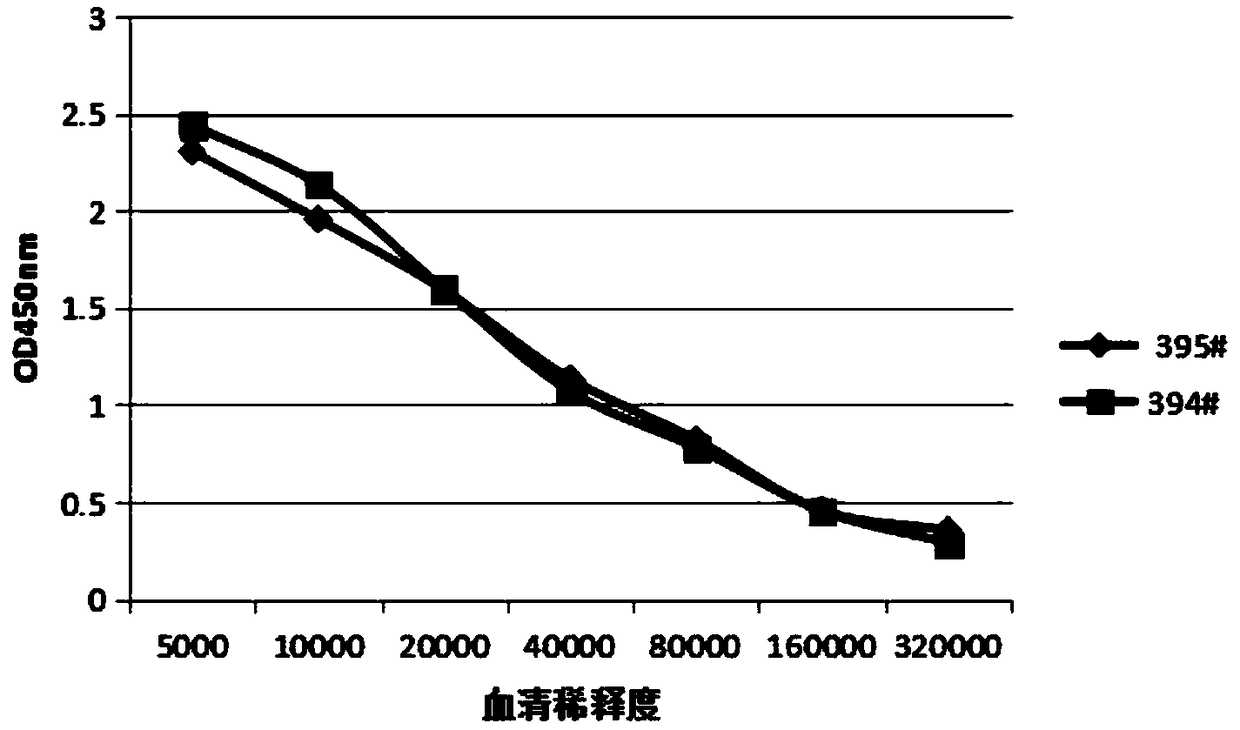Hybridoma cell line scca1 and its secreted monoclonal antibody and application
A hybridoma cell line and monoclonal antibody technology, applied in the field of clinical diagnosis, can solve the problems of low sensitivity and low SCCA specificity, and achieve the effects of high sensitivity, fast detection speed and accurate detection results
- Summary
- Abstract
- Description
- Claims
- Application Information
AI Technical Summary
Problems solved by technology
Method used
Image
Examples
Embodiment 1
[0024] Example 1 Preparation of hybridoma cell line SCCA1
[0025] Include the following steps:
[0026] 1. Preparation of antigen (SCCA1 recombinant protein)
[0027] Include the following steps:
[0028] 1), construction of pET28a-SCCA1 recombinant vector
[0029] According to the DNA sequence (NC_000018.10) of human SCCA1 (full length 1173bp) provided in Genbank, the sequence was artificially synthesized, the N-terminal signal peptide was removed, three pairs of primers were designed, and NdeI and XhoI were respectively introduced from the 5' ends of the two primers Restriction restriction site, four fragments of SCCA1 gene are amplified by conventional PCR method (vector pET-28a is template), respectively express four sections of sequence of SCCA1 protein: first section: the 93rd to the 159th amino acid (SEQ ID No: 1); second paragraph: amino acid 44 to 102 (SEQ ID No: 2); third paragraph: amino acid 52 to 112 (SEQ ID No: 3); fourth paragraph: full length , amino aci...
Embodiment 2
[0047] Example 2 Preparation and purification of mouse anti-SCCA ascites monoclonal antibody
[0048] Include the following steps:
[0049] a. Choose female healthy BALB / c mice aged 8-12 weeks, intraperitoneally inject pristane, 0.5mL / only; after 7-10 days, give each mouse intraperitoneal injection of 1*10 6 ~5*10 6 For the three monoclonal hybridoma cell lines SCCA1-1, SCCA1-2, and SCCA1-3 of Example 1, each monoclonal hybridoma cell was injected into two mice. Note that blowing off the cells from the culture dish or diluting the cells requires PBS or serum-free medium;
[0050] b. Centrifuge the ascitic fluid at 10,000r / min for 15 minutes to remove cell components and other sediments, fat and oil layers, and collect the middle layer;
[0051] c. Precipitation of saturated ammonium sulfate: absorb 5mL of the middle layer and transfer it into a small beaker, under stirring, add 5.0mL of PBS that has been filtered through a 0.22μm membrane dropwise; after mixing evenly, add ...
Embodiment 3
[0057] Example 3 Specific identification of the monoclonal antibody of Example 2
[0058] In this example, the SCCA1 recombinant antigen and CA125, CA153, CEA, AFP, HE4, GP73 proteins described in Example 1 were used as the coating antigen, and the monoclonal antibody prepared in Example 2 was used as the recognition antibody, SCCA was detected by indirect ELISA.
[0059] 1) Coating of the microtiter plate
[0060] Coating solution (Na 2 CO 3 1.5g, NaHCO 3 2.9g, Na 2 N 3 1.2g, add ddH 2 (0 to 1 L, adjust the pH to 9.6) Dilute the coated antigen to 1 μg / mL, mix well and add to a 96-well ELISA plate, 100 μL per well, seal the plate at 4°C overnight.
[0061] 2), the sealing of the enzyme plate
[0062] PBS containing 5% skim milk was used as blocking solution. First, pat dry the ELISA plate coated overnight, add 200 μL / well blocking solution, block at 37°C for 2 hours, wash the plate 6 times with a plate washer, pat dry the ELISA plate, and store it at 4°C for later ...
PUM
| Property | Measurement | Unit |
|---|---|---|
| Sensitivity | aaaaa | aaaaa |
| Sensitivity | aaaaa | aaaaa |
| Sensitivity | aaaaa | aaaaa |
Abstract
Description
Claims
Application Information
 Login to View More
Login to View More - R&D
- Intellectual Property
- Life Sciences
- Materials
- Tech Scout
- Unparalleled Data Quality
- Higher Quality Content
- 60% Fewer Hallucinations
Browse by: Latest US Patents, China's latest patents, Technical Efficacy Thesaurus, Application Domain, Technology Topic, Popular Technical Reports.
© 2025 PatSnap. All rights reserved.Legal|Privacy policy|Modern Slavery Act Transparency Statement|Sitemap|About US| Contact US: help@patsnap.com



